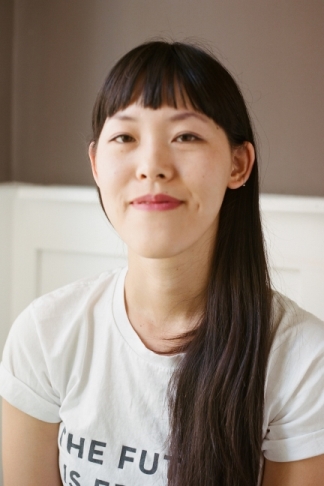Jen Wang Draws from Reality
Jen Wang's childhood experiences and eye for detail informed Stargazing, her new graphic novel about an unlikely friendship.
Opposites attract in Jen Wang’s graphic novel Stargazing (First Second, Sept. 2019; Gr 3-6). Straitlaced Christine Hong obsesses over her grades and her violin playing, but when bold, whimsical Moon Li and her mother rent a house from the Hongs, Christine’s world opens up. Wang was inspired by her own childhood to tell this gentle tale of friendship, and she discussed with SLJ her artistic style, the role of food in literature, and the complexity of identity.
 |
| Photo by Ye Rin Mok |
Stargazing is rooted in your childhood experiences. How much of the book comes from your own life?
The book is a work of fiction but most of the story is drawn from my own life, if not literally, then thematically. Growing up, I had trouble figuring out how I fit in culturally with other Asian American kids. At the same time, I had very typical experiences like any other kid, like figuring out friendships and jealousy, which I wanted to incorporate as well.
There’s been so much conversation about the need for diversity within children’s and YA fiction. But your book showcases diversity within a Chinese American community. How did you shape Moon and play with the ways in which she doesn’t quite belong?
Moon was easy to shape because I took a lot of her differences from myself. My family was Buddhist and vegetarian, I was not particularly good at school, and I loved to draw. Personality-wise, though, I’m a lot more shy and sensible like Christine. I decided to write from Christine’s perspective because I thought it might be more interesting, given [that] she’s less like me on the surface.
Labels play a big role in the book—“smart girls” vs. girls who are interested in makeup and clothes; “Asian” vs. “not Asian”; vegetarian vs. nonvegetarian. Why do these labels weigh so heavily for Christine?
I think Moon and Christine are generally at an age when rules and labels matter a lot. You’re just starting to figure yourself out, so you’re very attuned to the differences in people around you. Christine hasn’t known anyone like Moon before, so it causes her to question a lot of things about herself.
While you employed a vibrant style for The Prince and the Dressmaker, you went with a more spare look for Stargazing.
I knew I wanted Stargazing to look different. I wanted it to feel a little more casual, intimate, and down to earth. So instead of brush inking, I went with ballpoint pen. Which was actually a lifesaver, because it caused me less wrist pain to do as well! This is also the first book [where] I had someone else do the colors. Lark Pien did an amazing job and added so many details I would never have thought to bother with, like clothing patterns and labels.
The excerpts from Moon’s sketchbook have a more childish, raw look. How did you capture that difference?
Moon’s drawings are fun. I just tried to keep things really loose and natural, like I was doodling in a notebook in class. Also the faster you go, the less time you have to worry about details. It’s a more honest drawing!
 Food also figures strongly in the book—why was that important?
Food also figures strongly in the book—why was that important?
I think a lot of Asian Americans have a strong attachment to the food of their culture. It’s something you mostly ate at home and reminds you of your family. You weren’t able to eat a lot of that kind of food at restaurants until very recently, so it triggers a very personal feeling of identity. I think a lot of Asian Americans [who are] looking to connect with their culture find a lot of sensory comfort there as well as a sense of history.
Both this book and The Prince and the Dressmaker have a hint of the magical or fantastical (the fairy-tale feel of Prince; Moon’s fantasies about the stars), but the books, especially Stargazing, are generally rooted in reality. Where do you draw the line between realistic fiction and fantasy?
I’m a pretty reality-based person. A lot of what I find interesting in stories is small details in how a person might behave or feel, so I don’t end up spending a lot of time on world-building. It’s just easier for me to draw from reality.
Artists have created graphic novel adaptations of everything from fairy tales to Shakespeare plays to kid lit classic. What story would you most like to adapt, and why?
It would be fun to adapt a Chinese folktale sometime. My mom read us a lot of stories growing up, and they feel a part of my DNA. As far as novels go, I am currently working on a story that’s based on one of my favorite books as a kid. But you’ll have to wait to find out!
RELATED
The job outlook in 2030: Librarians will be in demand
The job outlook in 2030: Librarians will be in demand
ALREADY A SUBSCRIBER? LOG IN
We are currently offering this content for free. Sign up now to activate your personal profile, where you can save articles for future viewing






Add Comment :-
Be the first reader to comment.
Comment Policy:
Comment should not be empty !!!